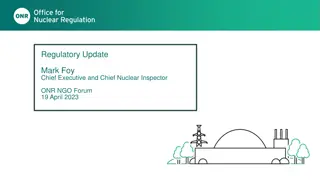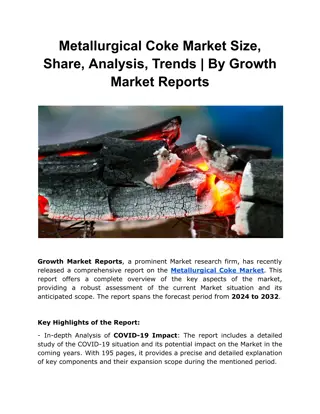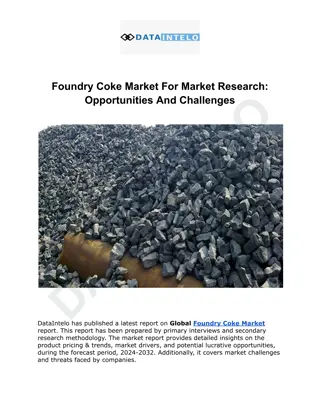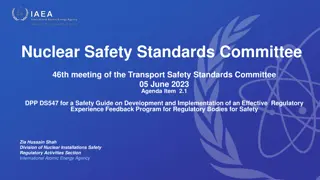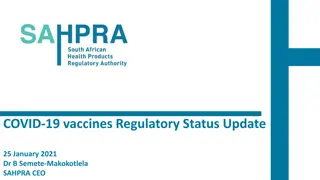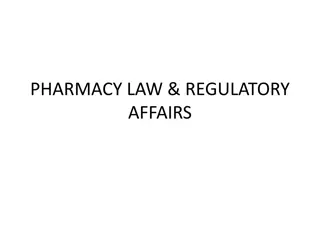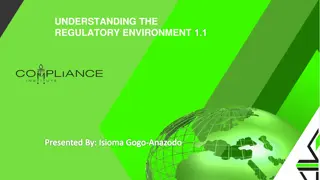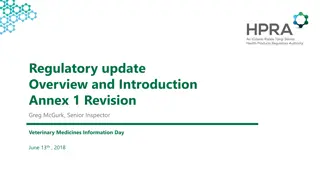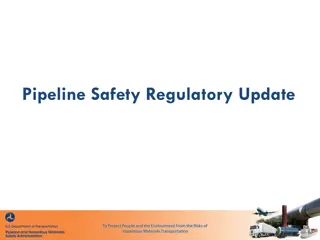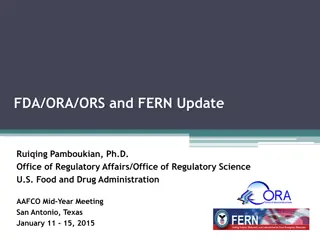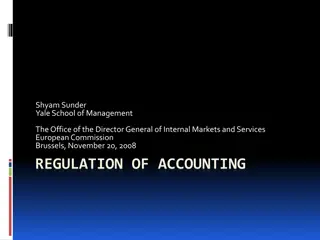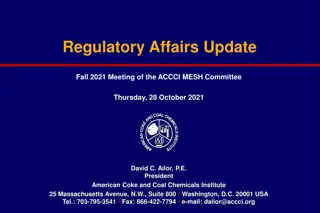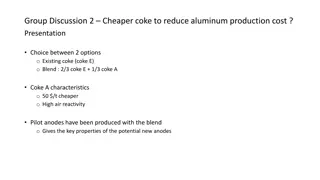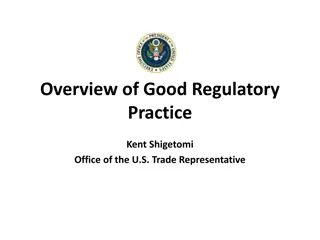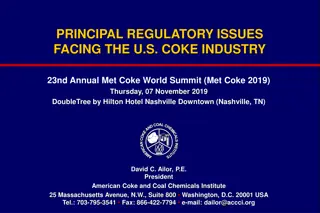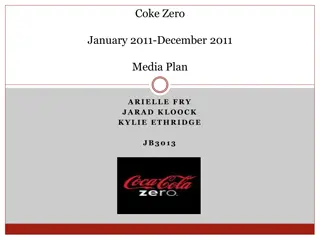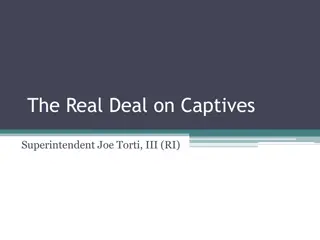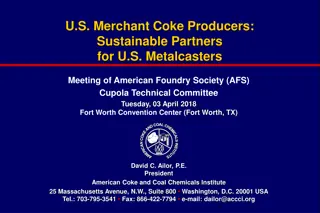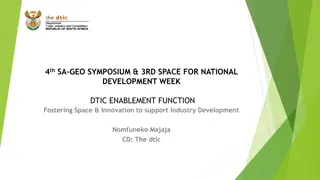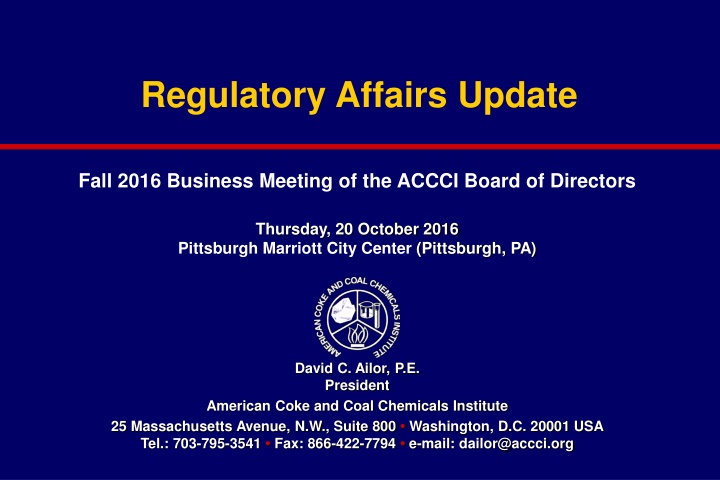
Update on U.S. Coke Industry Regulatory Affairs
The American Coke and Coal Chemicals Institute (ACCCI) presents key sector-specific regulatory issues concerning the U.S. coke industry. Learn about EPA's Risk and Technology Review (RTR) of 2003 MACT Standards for Coke PQBS and more. Get insights into the current status of the U.S. coke industry and the background of the Coke Oven Environmental Task Force (COETF).
Download Presentation

Please find below an Image/Link to download the presentation.
The content on the website is provided AS IS for your information and personal use only. It may not be sold, licensed, or shared on other websites without obtaining consent from the author. If you encounter any issues during the download, it is possible that the publisher has removed the file from their server.
You are allowed to download the files provided on this website for personal or commercial use, subject to the condition that they are used lawfully. All files are the property of their respective owners.
The content on the website is provided AS IS for your information and personal use only. It may not be sold, licensed, or shared on other websites without obtaining consent from the author.
E N D
Presentation Transcript
Regulatory Affairs Update Fall 2016 Business Meeting of the ACCCI Board of Directors Thursday, 20 October 2016 Pittsburgh Marriott City Center (Pittsburgh, PA) David C. Ailor, P.E. President American Coke and Coal Chemicals Institute 25 Massachusetts Avenue, N.W., Suite 800 Washington, D.C. 20001 USA Tel.: 703-795-3541 Fax: 866-422-7794 e-mail: dailor@accci.org
PRESENTATION OVERVIEW Principal Sector-Specific Regulatory Issues of Concern to the U.S. Coke Industry Principal General Industry Regulatory Issues of Concern to the Coke Industry Principal Regulatory Issues of Concern to the Coal Chemicals Industry Other Important Regulatory Affairs Issues 2
CURRENT STATUS OF THE U.S. COKE INDUSTRY 16 operating coke plants (54 batteries) 6 integrated steel by-product recovery plants (20 batteries) 5 merchant by-product recovery plants (10 batteries) 5 merchant heat-recovery plants (20 batteries) ACCCI addresses key regulatory issues facing the U.S. coke industry. ACCCI-managed Coke Oven Environmental Task Force (COETF) addresses key environmental issues facing the U.S. by-product recovery coke industry. 3
BACKGROUND ON THE COETF The COETF was formed by the American Iron and Steel Institute (AISI) and ACCCI in 1996 to address major environmental issues collaboratively. The COETF operates as a semiautonomous, self-funded entity. The COETF represents all 11 U.S. by-product recovery plants (30 by-product recovery batteries). 6 integrated steel by-product recovery plants (20 batteries) 5 merchant by-product recovery plants (10 batteries) Five heat recovery coke plants (20 batteries) are not represented/participating in the COETF. The COETF needs a new chair - COETF Chairman Mark Poling (ABC Coke) is retiring. 4
PRINCIPAL SECTOR-SPECIFIC REGULATORY ISSUES OF CONCERN TO THE U.S. COKE INDUSTRY EPA s Risk and Technology Review (RTR) of 2003 MACT Standards for Coke PQBS CAA 112(c)(6) Litigation 5
EPAS RISK AND TECHNOLOGY REVIEW (RTR) OF 2003 MACT STANDARDS FOR COKE PQBS On April 14, 2003, EPA promulgated maximum achievable control technology (MACT) standards for coke pushing, quenching and battery stacks (PQBS). Standards are to limit hazardous air pollutants (HAPs) from PQBS (e.g.,benzene, toluene, coke oven emissions ). Clean Air Act (CAA) requires EPA to determine within eight years of promulgation (i.e., by 2011 for PQBS) whether tighter standards should be issued, based on: risks to public health associated with MACT-level emissions (risk review); and, whether any improvements in control technology have occurred since the MACT standards were issued (technology review). EPA is behind schedule on the RTR for coke PQBS, having just kicked off the multi-year (three- to-four year) RTR in early 2015. The rulemaking is NOT subject to a court-ordered deadline, but is a high priority of EPA s Acting Assistant Administrator for Air and Radiation, Janet McCabe. The EPA-OAQPS Project Officer, Dr. Donna Lee Jones, indicated a willingness to work with us to adjust/ pare back the testing requirements, on the basis of justified safety, timing and expense issues. 6
EXPECTED COETF ISSUES ON THE PQBS RTR Scope of EPA s Information Collection Request (ICR) Unit risk estimate for Coke Oven Emissions Underlying exposure assumptions for EPA s risk estimates Dispersion modeling Emission factors Cost to comply 7
INITIAL EPA EFFORTS ON THE PQBS RTR EPA provided the COETF with a draft Information Collection Request (ICR) during August 2015 for comment. Enclosure 1: Questionnaire, which asks questions about the company and all of the operations at its coke plant(s) Enclosure 2: Testing request, which includes all of the details of where and how to test From August 2015 through March 2016, the COETF engaged EPA on the draft ICR. 8
COETF EFFORTS ON THE DRAFT ICR Beginning in September 2015, the COETF pushed back on EPA regarding the draft ICR, arguing that: In consideration of current business conditions facing the steelmaking and cokemaking industries, EPA should place on temporary hold the ICR/RTR process until the industries become financially stable and are back to normal and representative production. If EPA moves forward, it is imperative that any data collection effort associated with the ICR be efficient and focus on safely generating accurate, relevant Coke Pushing, Quenching, Battery Stack (PQBS) MACT information necessary to comply with CAA 112(f) requirements. The COETF utilized outside consultants in pushing back, and has identified outside counsel to utilize when legal questions/issues arise. 9
EPAS FINAL (APRIL 2016) PQBS ICR Date ICR Item No. Weeks* 0 Letter stamped date 4-Apr-16 3 Submit e-copy of most recent air permit 25-Apr-16 5 Submit detailed explanation of testing problems 9-May-16 9 Submit names of Quench Tower testing facilities 6-Jun-16 9 Submit any previous test reports applicable to tests 6-Jun-16 12 27-Jun-16 Submit schedules(s) for testing** 17 1-Aug-16 Submit Enclosure 1 responses-Group 1 (Sections I, II, III) ** 21 days before testing Notify your state of upcoming tests*** 23 Submittal #2, Sections IV and V (Group 2) 12-Sep-16 29 Submittal #3, Sections VI and VII (Group 3) 24-Oct-16 34 Advice: Stop testing at least 6 weeks before reports due 28-Nov-16 37 Submittal #4, Sections VIIII, IX, X (Group 4) 19-Dec-16 Submit test reports & data spreadsheets (Enclosure 2) 40 9-Jan-17 * From stamped date of EPA letter; due close of business end of week indicated. ** Revised April 14, 2016 *** Please copy Dr. Jones, U.S. EPA, on the notice at Jones.DonnaLee@epa.gov 10 (continued)
EPAS FINAL (APRIL 2016) PQBS ICR (Concluded) - Parent /Affiliated Company ArcelorMittal ArcelorMittal ArcelorMittal AK Steel Corporation AK Steel (separate inc.) DTE Energy Services, Inc Erie Coke Corporation United States Steel Corp. Firm Name # Co. City State Letters Enc 1 Encl 2 ArcelorMittal Monessen ArcelorMittal Burns ArcelorMittal Warren AK Steel Mountain State EES Coke Battery Erie Coke Corporation US Steel Clairton Works Haverhill North Coke Middletown Coke Gateway (separate inc.) (separate inc.) (separate inc.) 1 2 3 4 5 6 7 8 Monessen Burns Harbor Warren Middletown Follansbee River Rouge Erie Clairton Franklin Furnace Middletown Granite City PA IN OH OH WV MI PA PA OH OH IL 1 2 3 4 5 6 7 8 1 2 3 4 5 6 7 8 9 10 11 11 1 2 Harbor no 3 no no 4 5 Carbon . 6* Suncoke Energy, Inc . 9 9 7 7 Totals 9 9 * Choice of one of these two facilities for testing; both facilities will submit Enclosure 1 Questionnaire. 11
COETF EFFORTS ON THE FINAL (APRIL 2016) PQBS ICR Since EPA s release of the final ICR, the COETF has served as a roundtable for discussing how individual companies plan to the various questions EPA is posing and deciding what responses would best serve the industry s interests. In June 2016, the COETF formed a Modeling Subgroup to review/consider and make recommendations to the COETF on what to advocate to EPA in terms of RTR modeling, and when. In September 2016, the COETF agreed on the text of a footnote for companies to consider including in their Group 2 (Sections IV and V) submissions to EPA on the ICR. The footnote advocates for EPA to use the buoyant volume source approach for modeling coke battery fugitive emissions. 12
CAA 112(c)(6) Litigation CAA 112(c)(6) requires source categories responsible for at least 90% of the aggregate emissions of seven PBA HAPs to be subject to standards under CAA 112(d)(2) [MACT] or 112(d)(4) [risk-based for specified HAP]. One of the seven HAPs is associated with coke oven emissions - polycyclic organic matter (POM). (continued) 13
CAA 112(c)(6) Litigation (continued) In June 2015, EPA issued a rule stating that it had satisfied 112(c)(6) by promulgating standards for numerous specified source categories, including the NESHAPs for coke oven charging/topside/doors, by-product recovery plants, and PQBS. ENGOs filed comments on the proposed rule that EPA had not satisfied its 112(c)(6) obligations with respect to POM from coke ovens because COE is not an appropriate surrogate for POM. ENGOs argue that EPA must promulgate new MACT standards for coke ovens specifically regulating POM. (continued) 14
CAA 112(c)(6) Litigation (Concluded) In July 2015, ENGOs challenged the 112(c)(6) determination (Sierra Club v. EPA). Sierra Club filed its opening brief the week of March 28, 2016; EPA s response brief is due May 27, 2016. In June 2016, an industry coalition comprised of seven associations (ACC, ACA, AF&PA, AFPM, AISI and NACWA) filed an amicus brief in support of EPA, arguing: ENGO claims are time barred; ENGO claims raised previously and not pursued; and, EPA developed an adequate factual basis for use of surrogates. Oral argument is anticipated in early 2017. 15
PRINCIPAL GENERAL INDUSTRY REGULATORY ISSUES OF CONCERN TO THE U.S. COKE INDUSTRY EPA s Greenhouse Gas Policies EPA s SSM Policies EPA s Ozone NAAQS Final Rule EPA/U.S. Army Corps Of Engineers Waters of the U.S. (WOTUS) Final Rule EPA s RMP and OSHA s PSM Review/Rulemaking PEER Petition Regarding EPA s RCRA Corrosivity Characteristic 16
EPAS GREENHOUSE GAS POLICIES On August 3, 2015, EPA took three separate but related actions to address carbon pollution from power plants: Final Clean Power Plan, President Obama s signature effort to combat carbon emissions from existing power plants; Final Carbon Pollution Standards for new, modified and reconstructed power plants; and, Proposed Federal Implementation Plan associated with the final Clean Power Plan. The Clean Power Plan, originally proposed by EPA in June 2014, is the country s first regulation of carbon emissions from the Nation s 1,500 existing power plants. the largest source of the nation s GHG pollution. Other sectors could be addressed at any time as sector-specific NSPSs are revised. 17 (continued)
EPAS GREENHOUSE GAS POLICIES (Concluded) The associated standards could lead to the shutdown of coal plants before there is enough alternative power to replace them and, ultimately, to soaring electric bills, power blackouts and years of legal battles. If the Clean Power Plan and the other final rules survive judicial review without substantial change, they will significantly alter the way states and utilities design, plan, and operate our bulk power electric grid for decades to come. ACCCI has joined a new multi-association coalition being led by the National Association of Manufacturers (NAM, of which ACCCI is a member) and the U.S. Chamber of Commerce, which is challenging the new rules. Oral argument in West Virginia v. EPA was held on September 27, 2016. A decision is anticipated in early 2017. 18
EPAS SSM POLICIES In 2008, in Sierra Club v. EPA, a three judge panel of the U.S. Court of Appeals for the D.C. Circuit, with one judge dissenting, vacated three provisions in the Part 63, Subpart A of EPA s General Provisions that set forth the general duty to minimize emissions during SSM events and exempted sources from MACT emission standards during SSM events. Since then, EPA has promulgated multiple rulemakings that are re-shaping the way emission standards under Clean Air Act sections 112 and 129 apply during SSM events. The new approach is affecting virtually all source categories subject to MACT standards, including those that apply to coke plants. EPA s position is that SS events are routine and predictable operating conditions and should be treated the same as normal or steady-state operating conditions (that is, subject to MACT floor or beyond-the-floor emission standards). EPA s position is that M events are not distinct operating conditions, and so it will not set unique standards for M events. (continued) 19
EPAS SSM POLICIES (continued) In June 2015, EPA issued a final rule in which it asserted that the State Implementation Plans (SIPs) of 38 states were inadequate because of the relief they provide for SSM events (the SSM SIP Call rule ). EPA issued SIP calls for specific, limited language in each state s SIP. EPA s findings of inadequacy are based on inconsistency with EPA policies, not some specific air quality problem. EPA s statements about what SIPs can and cannot say about SSM events are in guidance, not regulation. ACCCI has joined an SSM Coalition which, in August 2015, filed a petition for review of the SSM SIP Call rule in the U.S. Court of Appeals for the D.C. Circuit. 20 (continued)
EPAS SSM POLICIES (Concluded) State and industry petitioners in the litigation (Walter Coke v. EPA) are challenging EPA s elimination of SSM and affirmative defense provisions in 38 SIPs, arguing: that: No demonstration that SIPs are substantially inadequate to attain or maintain NAAQS; General duty and work practices provide at all times controls; and, Ban on affirmative defense provisions contrary to CAA. Briefing is essentially complete. Oral argument is anticipated in early 2017. SIPs are due in November 2016. 21
EPAS OZONE NAAQS FINAL RULE On October 1, 2015, EPA released its final National Ambient Air Quality Standard (NAAQS) for ozone, lowering the current 2008 standard of 75 parts per billion ( ppb ) down to a level of 70 ppb for both the primary and secondary standards. EPA lowered the ozone standard despite calls from numerous states, unions, and economic development agencies to retain the current standard. EPA s new ozone standards will place an enormous burden on the still-recovering American economy, causing a estimated 400% increase in nonattainment areas. Legislation being considered on Capitol Hill would provide a common-sense approach for implementing national ambient air quality standards, recognizes ongoing state efforts to improve air quality through a reasonable implementation schedule for the 2015 ozone standards, streamlines the air permitting process for businesses to expand operations and create jobs, and includes other reforms that bring more regulatory certainty to federal air quality standards. 22
EPA/U.S. ARMY CORPS OF ENGINEERS WATERS OF THE U.S. (WOTUS) FINAL RULE The final rule was issued on June 29, 2015 (80 Fed. Reg. 37,054). The rule became effective on August 28, 2015. The rule has implications for any entity regulated under the Clean Water Act (CWA), including construction, manufacturing, mining, agricultural, and energy development. It dramatically expands the number and types of waters subject to regulation under the CWA, as this definition establishes the scope of federal jurisdiction over U.S. waters. Where federal jurisdiction exists, federal permits will be necessary for a number of activities impacting these waters, including filling, dredging, discharging into, or modifying flow. This new definition of waters will also be incorporated into regulations under several other environmental laws, including the CAA, RCRA, and CERCLA. Litigation over the final rule continues. The final rule has been challenged in the courts by numerous parties and has been stayed pending that ongoing litigation. Congress continues to pursue various legislative actions to overturn/ defund the final rule (e.g., passage of a Congressional Review Act resolution of disapproval in January 2016, that was subsequently vetoed by President Obama). 23
EPAS RMP AND OSHAS PSM REVIEW/RULEMAKING EPA and OSHA, respectively, are moving forward aggressively to implement significant revisions to their Risk Management Plan (RMP) and Process Safety Management (PSM) rules that apply to facilities that use extremely hazardous substances. The agencies actions are in response to an Executive Order (EO), EO 13650, which President Obama issued on August 1, 2013, in response to an April 2013 explosion at a fertilizer facility in West, Texas, that killed 15 people and injured many others. In December 2013, OSHA announced that it was considering significant revisions to its PSM rule ("Process Safety Management and Prevention of Major Chemical Accidents ), which contains requirements for the management of hazards associated with processes using highly hazardous chemicals. On July 31, 2014, EPA announced that it was considering significant revisions to its RMP rule, which requires facilities that use extremely hazardous substances to develop an RMP. Both announcements came as a request for information (RFI). An RFI is frequently a federal agency's first public acknowledgment that it intends to pursue rulemaking. (continued) 24
EPAS RMP AND OSHA PSM REVIEW/RULEMAKING (Concluded) OSHA, EPA, and DHS are leading a Working Group established by EO 13650 to identify areas for regulatory reform. Given the broad applicability of the PSM and RMP standards across many industrial sectors, including the coke industry, future rulemakings of the sort contemplated by OSHA and EPA, respectively, could have significant operational and economic effects. On March 14, 2016, EPA published in the Federal Register a proposed rule that would make major changes to the accident prevention, emergency response and public availability of chemical hazard information requirements under its RMP regulations. A final EPA rule is anticipated before the Obama Administration leaves office. OSHA s rule is on a slower track. 25
PEER PETITION REGARDING EPAS RCRA CORROSIVITY CHARACTERISTIC The Public Employees for Environmental Responsibility (PEER) has petitioned EPA to lower the upper limit of the RCRA Corrosivity Characteristic (used to identify hazardous wastes) from pH 12.5 to pH 11.5, a 10-fold reduction; and, and to extend the standard to solid, as well as liquid materials. In June 2015, ACCCI has joined a 17-association coalition that is assisting EPA in evaluating the petition. In a September 30, 2015, letter to EPA, the coalition argued that: a rule that met the petitioners requests needlessly would subject an enormous quantity of materials, many of which currently are safely used for productive purposes, to RCRA hazardous waste requirements with no corresponding benefit in the form of improved worker, public, or environmental safety. In fact, amending the corrosivity characteristic as requested would result in classifying as hazardous millions of tons more material than could be accommodated in currently available Subtitle C landfills. On April 11, 2016, EPA published in the Federal Register a tentative decision to deny the PEER petition request to amend the RCRA corrosivity characteristic. PEER asked for and received a six-month extension of the comment deadline, to December 7, 2016. 26
PRINCIPAL REGULATORY ISSUES OF CONCERN TO THE COAL CHEMICALS INDUSTRY State/local legislation that would ban coal tar-based sealants Litigation Over EPA s 2015 Multi-Sector General Permit (MSGP) 27
STATE/LOCAL LEGISLATION THAT WOULD BAN USE OF COAL TAR-BASED SEALANTS Legislation that would ban use of coal tar-based sealants has been enacted or is being considered in various states/localities (e.g., NY, MI, MN, IL, ME, Chicago). Legislation is being driven by USGS scientists and handful of environmental activists and media. The Pavement Coatings Technology Council (PCTC) of which ACCCI is a member continues to push back aggressively on proposed bans, adverse publicity. PCTC is encouraging ACCCI to do more. ACCCI s Coal Chemicals Committee is undertaking two projects focused on "increasing awareness about the true hazards of coal tar and coal tar pitch. The projects, which are being undertaken by ARCADIS U.S., Inc., include performing a critical review of human studies/reports on coal tar and coal tar pitch (dermal exposures); and, testing for antagonism among PAHs in coal tar. 28
LITIGATION OVER EPAS 2015 MULTI-SECTOR GENERAL PERMIT (MSGP) On June 16, 2015, EPA issued its 2015 MSGP for stormwater discharges from industrial sources. The MSGP is the collective term for the CWA National Pollutant Discharge Elimination System (NPDES) program's general permits for stormwater discharges from industrial facilities spanning 29 sectors, including, but not limited to, chemical manufacturing, textile mills, and timber products. EPA reissues the MSGP every five years. (continued) 29
LITIGATION OVER EPAS 2015 MULTI-SECTOR GENERAL PERMIT (MSGP) (Concluded) On August 16, 2016, EPA reached a settlement in Clean Water Act (CWA) lawsuits filed over the 2015 MSGP by several ENGOs. ACCCI was a party to the settlement discussions between the ENGOs, EPA and industry. Key provisions in the settlement agreement are: EPA will sponsor and fund a National Research Council (NRC) study that will evaluate and provide recommendations on: (1) potential changes to current benchmark monitoring requirements used to evaluate the performance of stormwater control measures; (2) the feasibility of numeric retention standards (e.g., volumetric control standards for a percent storm size or based on percentage of imperviousness); and (3) the industrial sectors that EPA should prioritize for its consideration of increased monitoring requirements in the next permit cycle. EPA will propose that industrial facilities using coal tar sealant "to initially seal or to re-seal pavement and thereby discharge polycyclic aromatic hydrocarbons ('PAHs') in stormwater are not eligible for coverage under the MSGP and must either eliminate such discharges or apply for an individual permit." EPA will propose an escalating series of additional actions permittees must take when stormwater discharges exceed benchmark monitoring targets. EPA will propose measures aimed at preventing stormwater discharges that could result in recontamination of Comprehensive Environmental Response, Compensation, and Liability Act (CERCLA) sites. 30
OTHER IMPORTANT REGULATORY AFFAIRS ISSUES EPA Rulemakings/Issues EPA s Boiler MACT and CISWI Final Rules, and Related Litigation NAAQS Implementation Issues EPA s Environmental Justice (EJ) Program EPA s Implementation of Toxic Substances Control Act (TSCA) Reform Legislation Enacted in 2016 OSHA Rulemakings/Issues OSHA s Final Silica Rule OSHA s Injury and Illness Protection Program Other Issues Chemical Security Legislation 31
QUESTIONS? 32

